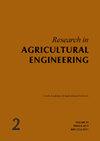腰果的工程特性在采收后处理和加工机械设计中的应用
Q3 Agricultural and Biological Sciences
引用次数: 2
摘要
确定腰果的工程特性是设计和开发合适和最佳的收获后处理和加工机械的基础。本研究检测了产自印度尼西亚中爪哇的腰果(n = 100)的物理、机械和颜色特性,其含水量为7.63%(湿基)。主要特征包括长度、宽度、厚度、质量、体积和密度。衍生性质包括几何直径、算术直径、表面积、前表面积、横向面积、形状指数、球度、容重和孔隙度。力学性能包括静摩擦、静、动休止角和压缩载荷(四个方向)。结果表明,中爪哇地区腰果为优势品种,大小中等,平均质量为5.42±0.99 g。这种腰果比印度、尼日利亚和象牙海岸的腰果更厚,但长度更短。逐步回归分析结果表明,体积与质量的相关性最强(R2 = 0.949),容重与质量的相关性最强(R2 = 0.968),孔隙度与真密度和真质量的相关性最强(R2 = 0.997)。胶合板表面的摩擦力、静休止角和动休止角最大,不锈钢表面的摩擦力最小。在设计合适的腰果开裂设备时,由于压缩载荷最小(减少功率要求),建议提供平行于纵轴方向的冲击。L*、a*、b*坐标的腰果色性分别为35.988、0.427、1.718。本文章由计算机程序翻译,如有差异,请以英文原文为准。
Engineering properties of the cashew nut in context of designing post-harvest handling and processing machinery
The determination of the engineering properties of the cashew nut is essential as the basis for the design and development of appropriate and optimum post-harvest handling and processing machinery. The present study examined the physical, mechanical and colour properties of cashew nuts (n = 100) at a moisture content of 7.63% (wet basis) derived from Central Java, Indonesia. The main characteristics included the length, width, thickness, mass, volume, and density. The derivative properties consisted of the geometric diameter, arithmetic diameter, surface area, frontal surface area, transverse area, shape index, sphericity, bulk density, and porosity. The mechanical properties included the static friction, static and dynamic angle of repose, and compressive load (in four orientations). It was identified that the cashew nut from Central Java was dominant with a small-medium size with an average mass of 5.42 ± 0.99 g. This cashew nut was thicker, but shorter in length than the cashew nuts from India, Nigeria, and Ivory Coast. The results of the stepwise regression analysis determined that the volume had the most substantial relationship with the mass (R2 = 0.949), the bulk density had the highest correlation with the mass (R2 = 0.968), and the porosity showed a high correlation with the true density and mass (R2 = 0.997). The highest friction, static angle of repose, and-dynamic angle of repose occurred on the surface plywood, and the lowest was on the stainless-steel surface. In the context of designing appropriate cashew nut cracking equipment, it was recommended to provide the impact parallel to the longitudinal axis orientation due to the minimum compressive load (reduce the power requirement). Furthermore, the cashew nut colour properties of the L*, a*, b* coordinates were 35.988, 0.427, 1.718, respectively.
求助全文
通过发布文献求助,成功后即可免费获取论文全文。
去求助
来源期刊

Research in Agricultural Engineering
Engineering, agriculture-
CiteScore
1.40
自引率
0.00%
发文量
21
审稿时长
24 weeks
期刊介绍:
Original scientific papers, short communications, information, and studies covering all areas of agricultural engineering, agricultural technology, processing of agricultural products, countryside buildings and related problems from ecology, energetics, economy, ergonomy and applied physics and chemistry. Papers are published in English.
 求助内容:
求助内容: 应助结果提醒方式:
应助结果提醒方式:


